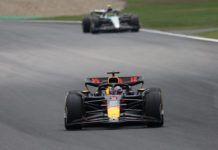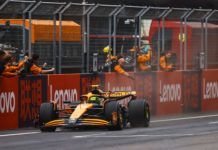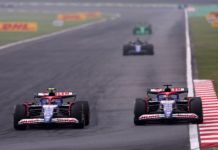Mercedes explains their findings from F1 US GP disqualification and how it came about, as it adds on handling the moment and strategy.
What looked like a promising weekend for Mercedes in F1 US GP with the updates they brought looking towards 2024, it ended up in a disqualification from second for Lewis Hamilton. Although, it helped George Russell gain places but they lost points too.
Hamilton is fighting for second in the standings against Sergio Perez, while Mercedes is defending second from Ferrari in the constructors’ side. The sprint weekend coupled with the bumpy nature of the Circuit of the Americas proved handful for certain cars.
While it is unknown how many cars would have failed the post-race plank test, the FIA found Hamilton and Charles Leclerc’s cars to be below the required number from among the four cars they had randomly checked. It was just unfortunate situation.
In their analysis post-race, James Allison noted that post FP1 they checked the plank and it looked all fine and so they chose the set-up they used which eventually wasn’t good enough with the margin and they fell short by the end of the race.
It was disappointing for Mercedes but they had to endure it and in a couple of days they were fine. Allison also discussed the strategy aspect where they went long with Hamilton and Russell with a hope to try one stop but it was clear that it isn’t possible.
Situation with plank and how it came about –
Mercedes: “The skid blocks are basically little discs of metal that are put into the plank material. At the end of the race have to be a guaranteed thickness. They begin the race at 10mm thick and by the time you get to the end of the race they must be no less than 9 mm. You are allowed a certain amount of erosion of that skid block by touching the ground but no more than 1 mm, else if your car is inspected and found to be below that 9 mm then you will have been deemed to running your car too low and you’ll be disqualified. Indeed, that is what happened in our case. The weekend was a very cast-iron vote of confidence in favour of what we put on the car, and that gives us great hope for the races that remain. But, the disqualification had everything to do with the setup and the bumpiness of the track, amplified by the fact that it was a sprint weekend. Normally in a race weekend you have three untimed sessions; Free Practice 1, 2 and 3 in which you gradually hone the setup of the car, getting it ready for qualifying on the Saturday and the race on Sunday.
“In that period of practice you are trying to get the car as fast, reliable, and legal as you can, making sure that you are ticking all the boxes that enable the car to get through to the end of the weekend fast and good shape for when you go into parc fermé. At a sprint weekend, you are under much more pressure, you have just a solitary hour at the very front of the weekend. In Free Practice 1 you have to get the car ready for the next session, which is qualifying, the next session which is sprint shootout, the next session which is the sprint race and then the race itself. After that one hour you have cast your die. You have chosen your setup and you have then got to run the rest of the weekend with the bets you placed in that one hour of running. That means much less time to assess things than normal and much less time to make corrective action ahead of the remaining sessions later in the weekend.
“Austin is a track with a very bumpy surface and therefore you are a bit more vulnerable to bumping the car on the ground. We just simply didn’t take enough margin at the end of Free Practice 1. When we had done our setup we checked the plank and everything all looked fine, untouched after the FP1 running. But the results of the race speak for themselves. We were illegal, so clearly, we should have had our car set a little bit higher up to give ourselves a little bit more margin. It’s of course a mistake, it’s an understandable sort of mistake in a sprint weekend where it’s so much harder to get that stuff right, especially on a bumpy track. But a lesson for us in the future to make sure that we take more margin especially at a track like that with all its bumps.”
Strategy decision to keep Lewis Hamilton out –
Mercedes: We should have done. We should have pitted Lewis, we should have kept ahead and we would have given ourselves a better chance of the win had we done so. But it’s good to understand where we were coming from, and also understand a bit more of the strategists’ dilemma. When we discussed the race that morning, our thinking was roughly this: We knew that we had been pretty pacy during the sprint race the day before, but we also knew that Max just had the edge on us. Austin is the sort of track where generally speaking the track tends to deal out the cars in pace order by the time the chequered flag falls at the end of Sunday, so we didn’t actually think we were in the same race as Max. We thought he would find a way of coming through the field. That’s the first thing, just in the back of our heads as the laps were playing out in that first stint on Sunday.
“The second thing is that when we did our analysis of the circuit and the running of the weekend thus far we thought that it was most likely a two stop race. We thought it would most likely be a race where the tyre degradation was high enough that it would be a two stop race. However, we didn’t discount the possibility on race day that if the degradation and lap time we saw ,it might move us from a two-stop into a one-stop race. The first stint was good. We were able to overtake those two Ferraris, going at a pace that was on par with Max and, a little bit quicker than the McLaren in front of us. When Max came in for his stop, we knew .The would undercut us a few laps later. That wasn’t a surprise. But we were in that period of optimism, looking at the flat lap times Lewis was producing and thinking this might be on. We weren’t going to beat Max just by doing the same thing as him because we knew from the Sprint race that we knew he was quicker than us. We were seeing if we could make this one stop work then we could beat.That’s why we didn’t cover Max off.
“We left Lewis out there and waited to see what would happen, hoping to see , hoping that the flat lap time progression continue. A lap went by and we’d effectively been undercut and we were were crossing our to see whether the pace evolved as we hoped. Unfortunately,Unfortunately, within a very short period of time, we had lost the ability to protect against Max, and Lewis’ lap times , Lewis’started to turn south, and we experienced as we went through the same degradation as everybody else, turning us into a two stop already. We to cover him off because actually the raw pace of the car was good enough to compete on equal terms with him and if we had just done a two stopper against his two stopper it could have been a different race.”
Highs and lows post race –
Mercedes: “Of course the disqualification is a significant blow. It’s a miserable feeling. It hurts and everybody here feels it. Everybody is upset, embarrassed to a degree as well because we absolutely don’t like like being on the wrong side of the rules and just lamenting the lost points. Give it day or two and that will start to wane and be replaced by the much happier feeling, which is we moved our car forward this weekend and that’s hard to do. But we did it and we did it by a decent amount. And with four races left in the championship, four races where I am sure we will stay on the right side of the skid block rules. The initial feeling hurt, disappointment and frustration will pass to be replaced by the sunny optimism of knowing that the car looked bright on this upgrade package and we’ve got four more races to show what we can do with it.”
Here’s Lando Norris, Lewis Hamilton on their duel
Here’s Mercedes, Ferrari reacting to DQ
Here’s what the FIA said about the DQ
Here’s link to a F1 Discord channel, join in to interact



















